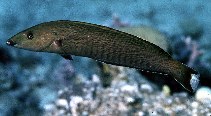http://www.fishbase.org/Summary/speciesSummary.php?genusname=Hologymnosus&speciesname=annulatus ---> http://192.134.151.83/Summary/speciesSummary.php?genusname=Hologymnosus&speciesname=annulatus
http://192.134.151.83/Summary/speciesSummary.php?genusname=Hologymnosus&speciesname=annulatus ---> https://fishbase.mnhn.fr/Summary/speciesSummary.php?genusname=Hologymnosus&speciesname=annulatus
https://fishbase.mnhn.fr/Summary/speciesSummary.php?genusname=Hologymnosus&speciesname=annulatus ---> https://fishbase.mnhn.fr/summary/Hologymnosus-annulatus.html
Hologymnosus annulatus, Ring wrasse : fisheries, aquarium

You can
sponsor
this page
Common name (e.g. trout)
Genus + Species (e.g. Gadus morhua)
-

-
About this page
-
Languages
-
User feedbacks
-
Citation
-
Uploads
-
Related species
-


 Ring wrasse
Add your observation in
Fish Watcher
Upload your
photos
and
videos
Ring wrasse
Add your observation in
Fish Watcher
Upload your
photos
and
videos
Pictures
|
Videos |
Google image
 Hologymnosus annulatus
Hologymnosus annulatus
Picture by
Randall, J.E.
Teleostei (teleosts) >
Eupercaria/misc
(Various families in series Eupercaria) >
Labridae
(Wrasses) > Corinae
Etymology:
Hologymnosus:
Greek, holos = full + Greek, gymnos = naked (Ref.
45335
)
.
More on author:
Lacepède
.
Environment: milieu / climate zone / depth range / distribution range
Ecology
Marine; reef-associated; depth range 8 - 40 m (Ref.
90102
). Tropical; 25°C - 28°C (Ref.
27115
); 32°N - 28°S
Indo-Pacific: Red Sea and South Africa (Ref.
11228
) to the Society and Pitcairn islands, north to southern Japan, south to southeastern Australia and Rapa Island.
Size / Weight / Age
Maturity: L
m
?
range ? - ? cm
Max length : 40.0 cm TL male/unsexed; (Ref.
2334
); common length : 34.0 cm TL male/unsexed; (Ref.
5450
)
Dorsal
spines
(total): 9;
Dorsal
soft rays
(total): 12;
Anal
spines
: 3;
Anal
soft rays
: 12. Two-color forms: the 'true' species in the Indian Ocean and Red Sea and its sibling in the Pacific regions. Females look almost black; males mainly greenish with blue face, of which Indian form shows a white band central to the body, whilst the Pacific form a pale peduncular area when in nuptial mode (Ref.
48636
). Juvenile
H. annulatus
very closely resemble juvenile
Malacanthus latovittatus
(Ref.1602). Poorly developed pharyngeal teeth (Ref.
1602
).
Found on coral reefs and rocky substrates to depths of at least 30 m (Ref.
9823
) on offshore reef slopes (Ref.
90102
). Juveniles generally solitary (Ref.
9710
). Feeds primarily on small fishes, also on crustaceans (Ref.
2334
).
Life cycle and mating behavior
Maturity
|
Reproduction
|
Spawning
|
Eggs
|
Fecundity
|
Larvae
Pelagic spawner.
Randall, J.E., G.R. Allen and R.C. Steene
, 1990. Fishes of the Great Barrier Reef and Coral Sea. University of Hawaii Press, Honolulu, Hawaii. 506 p. (Ref.
2334
)
IUCN Red List Status (Ref.
130435
)
Least Concern (LC)
; Date assessed:
02 March 2009
CITES
Not Evaluated
Not Evaluated
Threat to humans
Harmless
Human uses
Fisheries: minor commercial; aquarium: commercial
FAO - Publication:
search
|
FishSource
|
More information
Countries
FAO areas
Ecosystems
Occurrences
Introductions
Stocks
Ecology
Diet
Food items
Food consumption
Ration
Common names
Synonyms
Metabolism
Predators
Ecotoxicology
Reproduction
Maturity
Spawning
Spawning aggregation
Fecundity
Eggs
Egg development
Age/Size
Growth
Length-weight
Length-length
Length-frequencies
Morphometrics
Morphology
Larvae
Larval dynamics
Recruitment
Abundance
BRUVS
References
Aquaculture
Aquaculture profile
Strains
Genetics
Electrophoreses
Heritability
Diseases
Processing
Nutrients
Mass conversion
Collaborators
Pictures
Stamps, Coins Misc.
Sounds
Ciguatera
Speed
Swim. type
Gill area
Otoliths
Brains
Vision
Tools
Bio-Quiz
|
E-book
|
Field guide
|
Length-frequency wizard
|
Life-history tool
|
Point map
|
Classification Tree
|
Catch-MSY
|
Special reports
Check for Aquarium maintenance
|
Check for Species Fact Sheets
|
Check for Aquaculture Fact Sheets
Download XML
Summary page
|
Point data
|
Common names
|
Photos
Internet sources
AFORO (otoliths)
|
Aquatic Commons
|
BHL
|
Cloffa
|
BOLDSystems
|
Websites from users
|
Check FishWatcher
|
CISTI
|
Catalog of Fishes
:
genus
,
species
|
DiscoverLife
|
ECOTOX
| FAO - Publication:
search
|
Faunafri
| Fishipedia |
Fishtrace
| GenBank:
genome
,
nucleotide
|
GloBI
|
Google Books
|
Google Scholar
|
Google
| IGFA World Record |
MitoFish
|
National databases
|
Otolith Atlas of Taiwan Fishes
|
PubMed
|
Reef Life Survey
| Socotra Atlas |
Tree of Life
| Wikipedia:
Go
,
Search
| World Records Freshwater Fishing |
Zoological Record
Estimates based on models
Preferred temperature (Ref.
123201
): 24.7 - 29.1, mean 28 °C (based on 602 cells).
Phylogenetic diversity index (Ref.
82804
): PD
50
= 0.5625 [Uniqueness, from 0.5 = low to 2.0 = high].
Bayesian length-weight: a=0.00977 (0.00470 - 0.02030), b=3.07 (2.89 - 3.25), in cm total length, based on LWR estimates for this (Sub)family-body shape (Ref.
93245
).
Trophic level (Ref.
69278
): 4.2 ±0.73 se; based on food items.
Resilience (Ref.
120179
): Medium, minimum population doubling time 1.4 - 4.4 years (Preliminary K or Fecundity.).
Fishing Vulnerability (Ref.
59153
): Low to moderate vulnerability (30 of 100).
Price category (Ref.
80766
):
Very high
.
Nutrients (Ref.
124155
): Calcium = 43 [26, 71] mg/100g; Iron = 0.598 [0.353, 1.077] mg/100g; Protein = 18.7 [15.8, 20.9] %; Omega3 = 0.144 [0.091, 0.223] g/100g; Selenium = 27.8 [16.1, 51.1] μg/100g; VitaminA = 174 [54, 589] μg/100g; Zinc = 1.07 [0.74, 1.62] mg/100g (wet weight);
Back to Search
Random Species
Back to Top
Accessed through:
Not available
FishBase mirror site :
localhost
Page last modified by :
mrius-barile
- 20 July 2016
Fatal error
: Uncaught ArgumentCountError: Too few arguments to function checkEcotox(), 1 passed in /var/www/html/summary/speciessummary.php on line 2304 and exactly 3 expected in /var/www/html/includes/speciessummary.lib.php:2579 Stack trace: #0 /var/www/html/summary/speciessummary.php(2304): checkEcotox() #1 {main} thrown in
/var/www/html/includes/speciessummary.lib.php
on line
2579
|